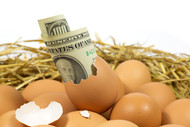Are You Kidding Me with These Egg Prices?
Posted by Jamie Shear Potash on 28th Feb 2023
Across national food chain grocery stores, costs for a dozen of packaged eggs have risen beyond consumers’ wildest dreams. According to January 19, 2023, article posted to Yahoo! Life (originally appearing in the Milwaukee Journal Sentinel), “Egg inventories are down after millions of chickens nationwide were destroyed because of exposure to avian influenza. The reduced number of birds, combined with rising costs of feed, fuel, labor and more, the average price of a dozen eggs has more than doubled in the past year” [referring to 2022].
The USDA Egg Markets Overview (a weekly publication dated 1/20/23), reports that “the volume of trailer load loose egg sales this week rose 66% from the prior week with 31% for future delivery. This is the most active movement since February 2022.” Although, Consumer demand for shell eggs continues decline as newly minted diets fade just as holiday bills are appearing in mailboxes across the country at a time when shell egg prices remain at unappetizing levels in retail outlets relative to other proteins.” In an eggshell: people are shopping other retail departments for protein that are more easily attainable, or less costly.
The article goes on to explain that the average cost of a dozen eggs could be anywhere from $3.99 (in the Midwest) to $9 depending on specialty types of eggs. Free range chickens usually garner higher costing eggs, vs. a traditional farm. From a production standpoint, chickens lay one egg a day, so it takes multiple hens to fill a crate of 12 or 18 eggs. “The inventory of nutritionally enhanced shell eggs declined 3% while stocks of organic eggs rose 3%.” This is perhaps not a coincidence, as more and more folks across the country are turning to locally sourced eggs from their neighbors. In response to the rising in store costs for eggs, and in good timing with more property owners realizing the potential they might have for homesteading, people turn to becoming the producers themselves.
To raise chickens, there must be an established parcel of land, and a heated structure for them to seek shelter from the elements and the dangers presented by predators and the outdoors. Even though free range chickens live an indoor/outdoor lifestyle, to retain their value as living beings, a solid start is to begin with the DeerBusters’ Hardware Cloth Fencing!
A food and water source will need to be researched. Got hay? Laying boxes? Some wood and nails? Chickens rid their area of bugs, ticks, and spiders since they are avid eaters. Surrounding fencing can be moved like a farmer would alternate fields for growing or grazing. Some young families have gone to the extreme of “borrowing” chicks and watching them hatch and raising them up until they’re big enough to go back to the hatchery. This is a wonderous life science class experience for children to see, however what happens to these fuzzy peeping yellow chicks once they’re “returned?”
Maybe national prices for a carton of eggs will drop in 2023, but in the meantime, people will still be wondering about that old adage about the chicken and the egg. And you don’t want to ask “why did the chicken cross the road” because if they were safely roaming inside a fenced area, we don’t have to imagine the sad ending to that barnyard question.

